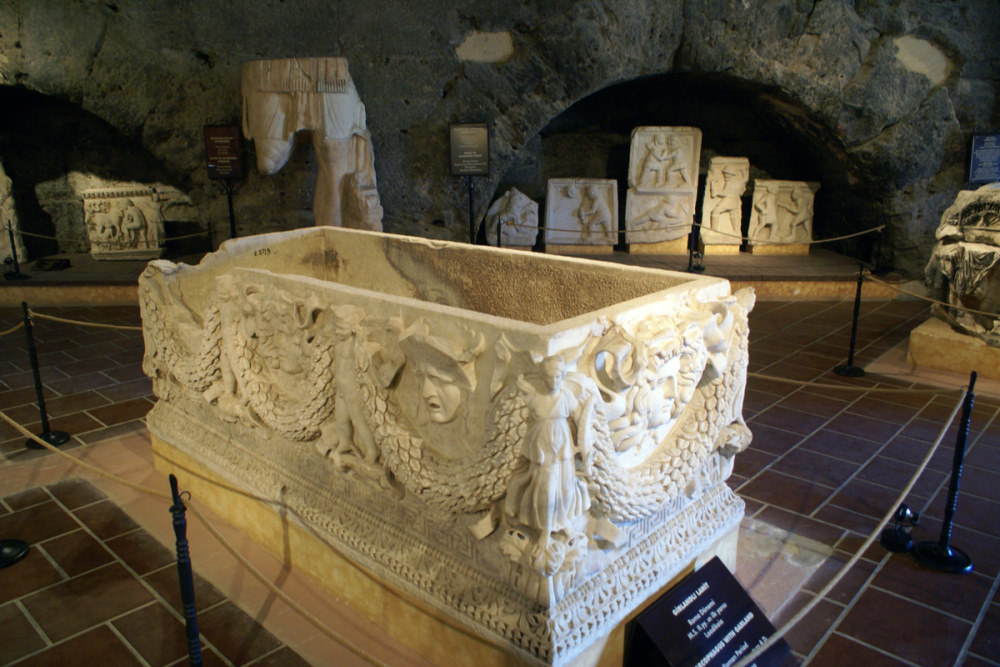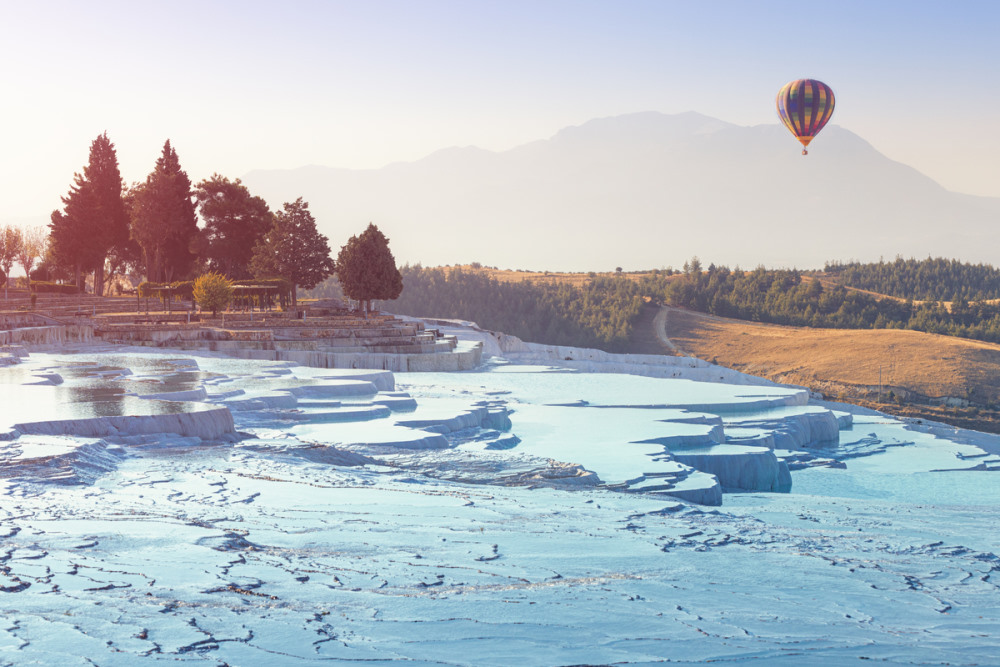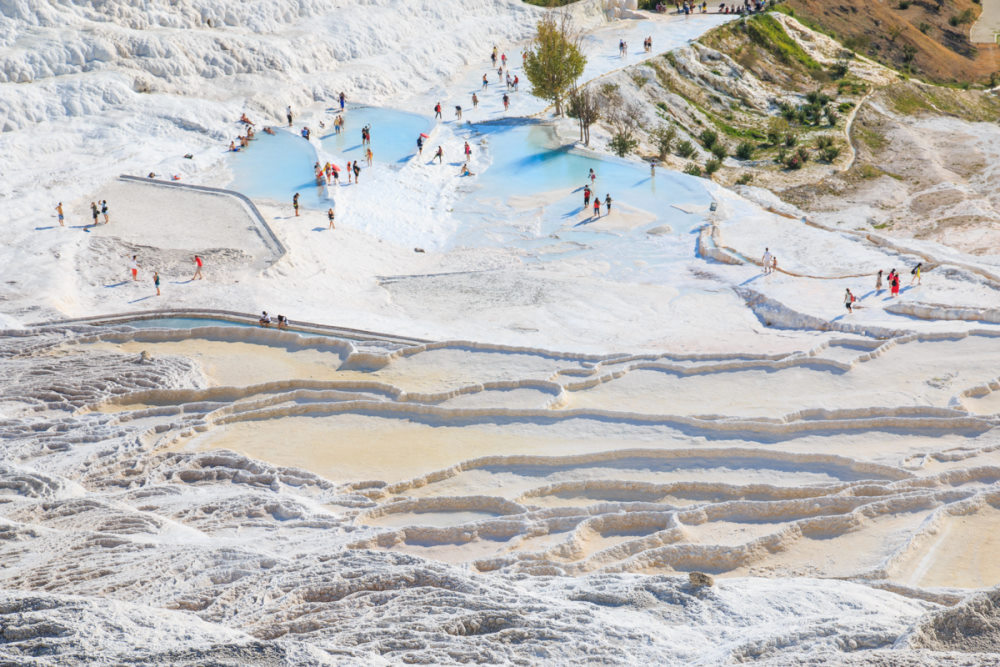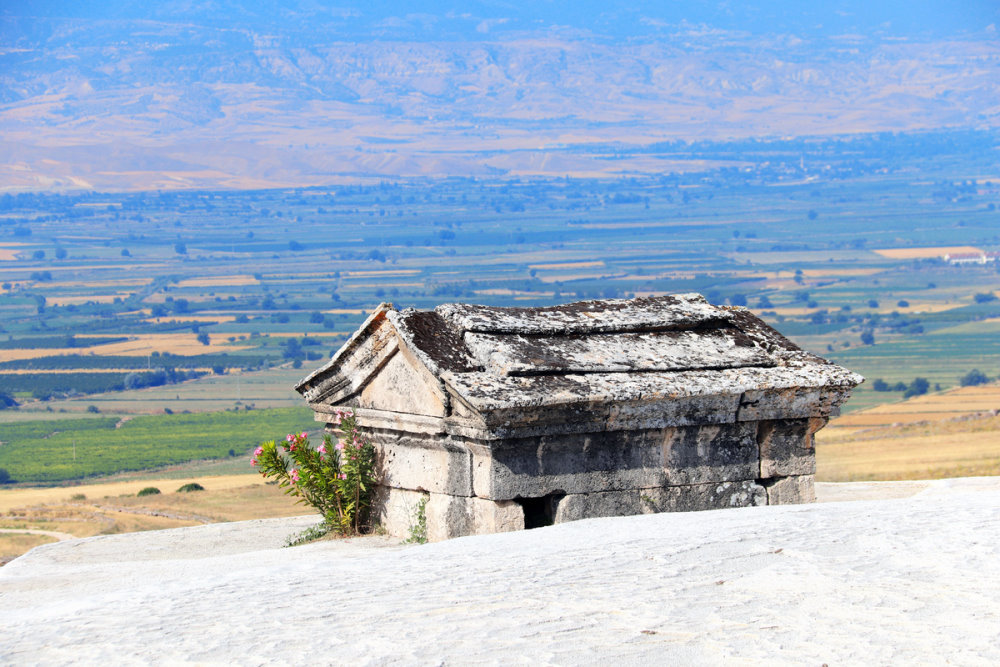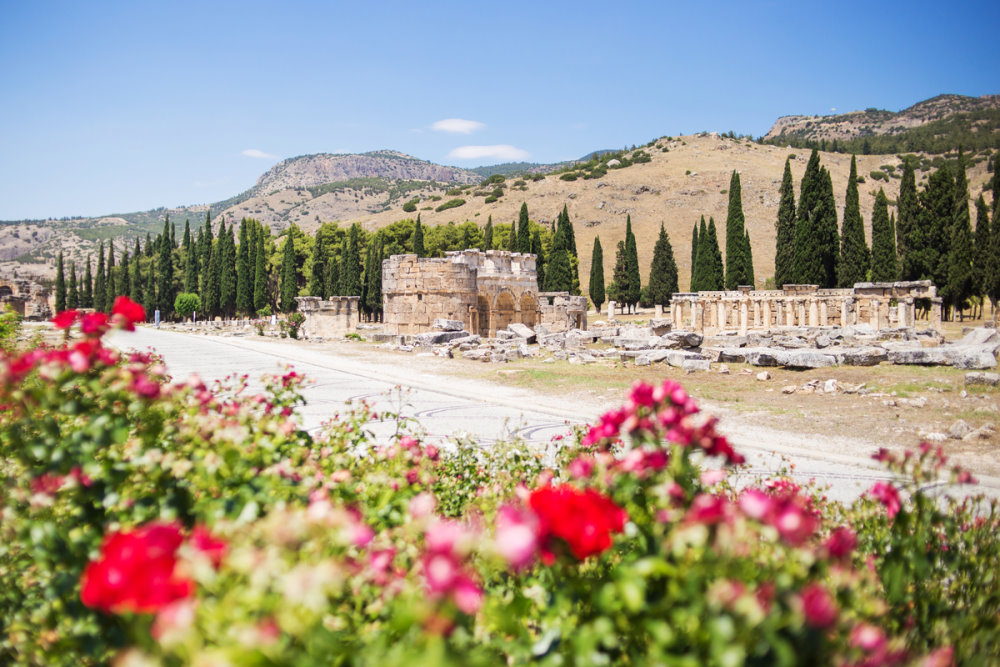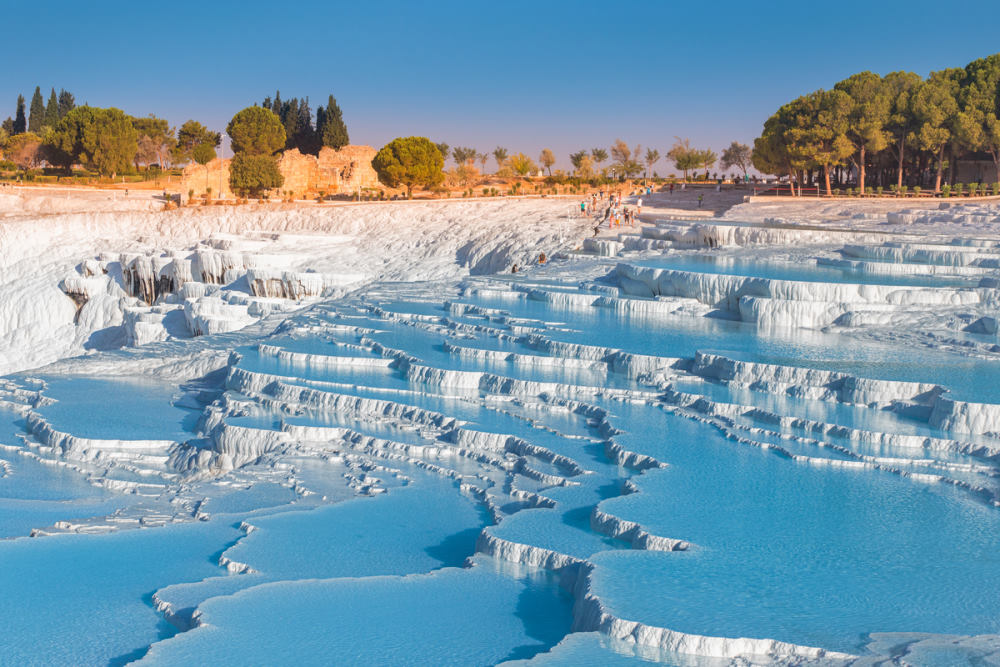Pamukkale is famous for its snow-white travertine terrace formations and thermal springs with healing water.
The natural travertine terraces are a UNESCO World Natural Site. They are located within the ruins of the ancient city Hierapolis which is a UNESCO World Heritage Site.
Together, they are one of the most popular attractions in Turkey with more than 2 million travellers visiting it each year.
In this complete guide, we will introduce you to everything that awaits you in Pamukkale, as well as helpful information and tips to make the most out of your visit.
Let's start!
Travertine Terraces
The most famous attraction of Pamukkale is undoubtedly the snow-white travertine terraces, which are also responsible for the naming of Pamukkale ("Cotton Castle").
The travertine terraces extend for about 2 kilometers. They are filled with turquoise thermal water, which contains carbonate mineral and calcium carbonate. It measures a pleasant temperature of 36 degrees and is said to have healing properties.
You can enter the travertine pools only in a designated area. A wooden walkway runs up the mountain face and leads to the first pool for visitors to use, from which they can go to many other pools. In some places it can be slippery, so caution is advised. Entering all other travertine terraces is prohibited to protect the natural monument.
You can bath and relax in the knee-deep travertine pools. The unique scenery is especially popular for photos. It becomes particularly magical at sunset, when the snow-white mountains take on a red-gold hue. This stunning natural spectacle is not to be missed.
Children can also swim here. Adults who want to swim in the thermal water can either go to the lake at the foot of the hill or to the Cleopatra Pool.
Meanwhile, visitors are not allowed to enter the travertine terraces with street shoes, as it was partly responsible for the discoloration and decline of the terraces.
Ruins of Hierapolis
Pamukkale was already a famous sight in ancient times. At that time, the city of Hierapolis was located here. In the Roman Empire Hierapolis was known as a healing center. The hot springs with thermal water were mainly visited by rheumatism, circulatory and heart patients.
Today visitors can see the remains of this ancient city. Some of them are over 2200 years old.
1. Theatre
The main attraction is the impressive Roman theatre dating back to 200 BC. During antiquity, it was able to accommodate 15,000 guests. Today it is possible to enter the theater. You can climb the rows of seats to the top and enjoy the breathtaking view of the former ancient city as well as the gorgeous travertine terraces.
2. Tomb of Apostle St. Philip
The tomb of Apostle St. Philip is also worth mentioning. It is located behind the theatre. A gravel path leads to the ruins of the church of St. Philip, dating from the Byzantine period.
3. Temple of Apollo & City Gate
Among the most famous buildings are also the city gate as well as the Temple of Apollo not far from the Cleopatra Pool. The ruins of the temple are well preserved and offer a magnificent view of the theatre.
4. Platonium
On the southern side of the Temple of Apollo lies the Platonium, a place of worship in honor of Pluto, the Roman god of the underworld. There were ritual animal sacrifices practiced in this site.
An interesting fact is that a poisonous volcanic gas leaks from the cave, which is why it is forbidden to enter it. This could be the reason why this cave was considered the "Gate to Hell" in ancient Greece.
Cleopatra Pool
A unique experience awaits visitors in the Cleopatra Pool, also known as Sacred Pool. You can swim here in thermal water among Roman ruins. These remains of ancient Roman columns collapsed into the water during several earthquakes. These earthquakes are also responsible for creating this hollow where the thermal water collected.
Today it is a very beautiful and popular place for swimming. There is an additional fee to enter the Cleopatra Pool. There are changing rooms, lockers and showers. There is also a café where you can relax and rest wonderfully.
In summer it can get quite crowded here. If you visit early in the spring or fall, however, with a little luck you may even have the Cleopatra Pool all to yourself.
Hierapolis Archeology Museum
At the Hierapolis Archeology Museum, visitors can admire impressive excavation treasures from the ancient city of Hierapolis and other parts of the region, covering a period of more than 4,000 years.
The museum, located in a large building that once served as Roman baths and a gymnasium, covers an area of 14,000 m2. There are three large exhibition halls in total, displaying sarcophagi, friezes, reliefs, statues and many other artifacts from the ancient world. In addition, you can discover Byzantine jewels, stone works, coins, as well as utility items such as oil lamps.
Necropolis
The necropolis, one of the largest in Anatolia, is also of great interest. Visitors can find three necropolis areas west of the travertine terraces beyond the city walls. It takes two to three kilometers to reach them from the south gate.
This large necropolis area stretches for 2 kilometers and is one of the best preserved in Turkey. It is filled with sarcophagi, architectural grave monuments and common tombs, as well as tombs of wealthy families who traveled to this healing center for medical treatment.
While most of the tombs date from the Late Hellenic era, there are also a significant number from the Roman and early Christian era.
Tandem Paragliding, Hot Air Balloon and other Activities
In addition to the dreamlike travertine terrace formations and ancient ruins, Pamukkale boasts two other spectacular attractions.
Visitors who want to admire the white paradise from the air can take a hot air balloon trip. Those who like more adrenaline can crown their stay with an unforgettable paragliding experience.
Where to eat / Food in Pamukkale
For those who crave a snack, there is a cafe right in front of the walkway, which leads to the accessible area of the travertine pools. Here you can enjoy some snacks and refreshments. Another cafe is located at Cleopatra Pool.
There are also plenty of restaurants in Pamukkale Town that serve traditional Turkish cuisine and international dishes.
Travel tips to Pamukkale
Entrance, Tickets and Tours
There are three entrances to Hierapolis-Pamukkale: the South Entrance, the North Entrance and the Pamukkale town entrance. They grant access to Pamukkale's travertine terraces as well as to the ruins of the ancient city of Hierapolis.
How to get to Pamukkale
Pamukkale is located 2 kilometers from the city of Denizli in southwestern Turkey. From Antalya, you can reach Pamukkale from various ways.
Book a Day Trip
A day trip is the easiest way to get to Pamukkale from Antalya. 1 and 2-day tours to Pamukkale-Hierapolis depart daily from all over Antalya, including Alanya, Kaş, Side and Belek. The trips are usually by bus. From Alanya or Side you spend about 5 to 6 hours in the tour bus.
Book a Bus Ticket
Alternatively, you can book a bus ticket and travel to Pamukkale on your own. From the bus station (otogar) in Kaş the journey takes about 5 hours. Therefore, taking an overnight bus is a good idea.
To get to Pamukkale from the bus station in Antalya, you need to drive to the bus station in Denizli and from there take one of the many buses that depart every 20 minutes to Pamukkale. After another 25 minutes you will reach Pamukkale.
Rent a car in Antalya
Another option to reach the site is by rental car. There are parking lots at the south and north entrance of Pamukkale-Hierapolis. Please note that there is a parking fee.
FAQ (Frequently Asked Questions)
Pamukkale is located 2 kilometers from the city of Denizli in southwestern Turkey.
The entrance fee for the archeological site of Pamukkale is determined as 110TL in 2021. This price includes the famous travertine terraces as well as the ancient city of Hierapolis.
Pamukkale is famous for its spectacular natural landscape that consists of snow-white travertine terraces with healing thermal water.
Other famous attractions that many people aren’t aware of are the ruins of the ancient city Hierapolis, the Hierapolis Archeology Museum, the Cleopatra Pool and the necropolis.
If you want to visit Pamukkale and Hierapolis, you should plan at least 2 hours. Those who want to explore everything in peace and also have enough time for the Hierapolis Museum, swimming in the Cleopatra Pool etc., are well placed with 3-4 hours. A day trip is therefore the perfect way to explore this breathtaking site.
If you plan on having adventures such as a paragliding flight or a tour in a hot air balloon, you should stay 2 days. Since the drive from Antalya is comparatively long at 4-6 hours, a 2-day trip with an overnight stay in a hotel is good option.
The best time to visit Pamukkale is in spring and autumn. Unlike the summer in which high temperatures up to 40 degrees can be expected, the weather is pleasant and mild. This allows you to explore the area best without being in the blistering heat. Another advantage is that it is then not so crowded in spring and autumn, because the summer is considered the peak season.
Hotel Options in Pamukkale
In the town of Pamukkale, below the breathtaking travertine terraces, there are a number of hotels overlooking this white paradise. Above the travertine terraces, on the other hand, there are few thermal hotels offering wellness and relaxation.
Here are two of the most popular thermal hotels as well as one city hotel in Pamukkale:
- Hierapark Thermal & Spa Hotel: Opened in 2017, Hierapark Thermal & Spa Hotel is a modern 4 star hotel. It is located 5 km from the ancient city of Hierapolis and the travertine pools. The hotel features a thermal bath, an outdoor pool and an aqua park for children. Address: Karahayıt Mahallesi 127 Kızılseki Sok No:15, 20190 Pamukkale/Denizli
- Richmond Pamukkale Thermal Resort: This thermal resort with an indoor pool with thermal spring water is situated above the travertine pools. This upscale 5-star hotel, which even hosts weddings, has elegant rooms and an idyllic surrounding overlooking the mountains. Address: Karahayıt, 20290 Pamukkale/Denizli
- Hotel Hal-Tur BOUTIQUE: Hotel Hal-Tur BOUTIQUE below the travertine terraces is located in the city of Pamukkale, just 3 minutes from the center. This 4-star hotel features elegant rooms with a great view of Pamukkale’s travertine terraces. It has a pool, a Sauna and offers paragliding as well as hot air balloon tours. Address: Mehmet Akif Ersoy Blv. No:71, 20280 Pamukkale/Denizli
History of Pamukkale
The spectacular landscape of Pamukkale was formed over thousands of years. Calcite-rich thermal springs have led to the formation of the snow-white travertine terraces.
With its thermal springs, the place is considered a center for thermal health for millennia. King Eumenes II of Pergamon founded the ancient Greco-Roman city of Hierapolis around the year 190 B.C. directly at these springs. The ancient city experienced its heyday in the 2nd and 3rd centuries. At that time, the thermal pools were frequented by people seeking relief from their suffering. The ruins of this ancient city are now one of the most famous sights in the area.
The thermal water of Pamukkale is said to have a healing effect on rheumatism, cardiovascular diseases, intestinal disorders as well as skin and nerve diseases.
In the last century, tourism in Pamukkale experienced a boom. At the beginning of the 20th century, hotels were built around the thermal springs, which tapped the hot springs. In addition, a road was built right next to the travertine terraces, causing exhaust fumes to pollute the air and water. These factors and mass tourism have caused the dazzling white travertine terraces to suffer greatly badly and become increasingly gray.
After Pamukkale was added to UNESCO's World Heritage List in 1988, a series of measures were taken to restore the site to its original state.
The hotels above the terraces were demolished, an irrigation system was introduced and visitors have only been allowed to enter strictly regulated areas.
The measures have already had an effect. The discoloration has already receded significantly and most of the travertine terraces are once again gleaming in brilliant white.
Today, Pamukkale is considered one of the most outstanding natural shows in the world. Pamukkale-Hierapolis is visited by hundreds of thousands of people every year.





